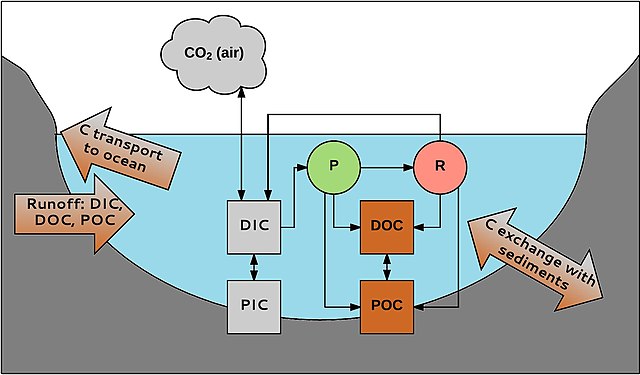Particulate organic matter
Particulate organic matter (POM) is a fraction of total organic matter operationally defined as that which does not pass through a filter pore size that typically ranges in size from 0.053 millimeters (53 μm) to 2 millimeters.
Marine particulate organic carbon (POC) POC includes components of living cells as well as dead material (detritus), and originates from both allochthonous and autochthonous sources. The POC pool can also exchange material with the dissolved OC (DOC) pool through aggregation and disaggregation of particles. This process and others may be involved in the formation of the molecularly uncharacterized component (MUC), which may incorporate both autochthonous and allochthonous OC.
Mean annual POC export at 100 m across the Southern Ocean
Dissolved organic carbon (DOC) is the fraction of organic carbon operationally defined as that which can pass through a filter with a pore size typically between 0.22 and 0.7 micrometers. The fraction remaining on the filter is called particulate organic carbon (POC).
Sources and sinks of dissolved organic carbon in the soil system
DOC and POC — DIC and PIC Inland waters primarily receive carbon from terrestrial ecosystems. This carbon (1.9 Pg C y−1) is transported to the oceans (0.9 Pg C y−1), buried in the sediments (0.2 Pg C y−1) or emitted as CO2 (0.8 Pg C y−1). More recent estimations are different: In 2013, Raymond et al. claimed CO2 emission from inland waters can be as high as 2.1 Pg C y−1. P = photosynthesis R = respiration
Simplified view of the main sources (black text; underlined are the allochthonous sources) and sinks (yellow text) of the oceanic dissolved organic carbon (DOC) pool. Main sources Most commonly referred sources of DOC are: atmospheric (e.g., rain and dust), terrestrial (e.g., rivers), primary producers (e.g., microalgae, cyanobacteria, macrophytes), groundwater, food chain processes (e.g., zooplankton grazing), and benthic fluxes (exchange of DOC across the sediment-water interface but also from
Dissolved organic carbon (DOC) fluxes in the surface, mesopelagic, and interior ocean In panel (A) oceanic DOC stocks are shown in black circles with red font and units are Pg-C. DOC fluxes are shown in black and white font and units are either Tg-C yr−1 or Pg-C yr−1. Letters in arrows and associated flux values correspond to descriptions displayed in (B), which lists sources and sinks of oceanic DOC.






